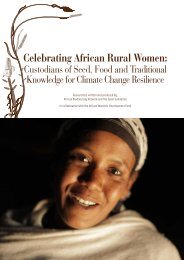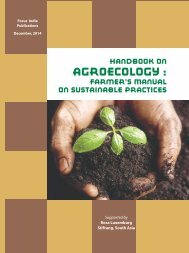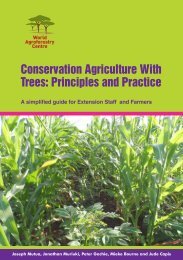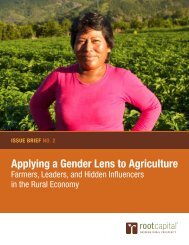1t0SC7l
1t0SC7l
1t0SC7l
Create successful ePaper yourself
Turn your PDF publications into a flip-book with our unique Google optimized e-Paper software.
Integrated Nutrient Management methods defined by Janssen (1993), based on combined<br />
application of mineral and organic fertilisers. Improved fallow and agroforestry technology<br />
packages are available at ICRAF.<br />
Prosperous farming: shifting cultivation should move from subsistence farming to income<br />
generating farming to guarantee food security and alleviate poverty of the local population. This<br />
can be made possible if the following parameters are improved or adopted: land tenure rights and<br />
laws, market system, integrated low input and short fallow agricultural system, improved fallow,<br />
integrated cropping system and improved animal husbandry, and diversification of farmers’<br />
crops. A survey carried out in the area (Table 5.2) shows the willingness of the farmers to adopt<br />
changes in the actual farming system.<br />
Table 5.2. Farmers’ predisposition to innovations<br />
Activities<br />
New<br />
crops<br />
Integration of improved<br />
animal husbandry<br />
Agricultural<br />
intensification<br />
Bee keeping Other<br />
innovations<br />
97 78 75 60 97<br />
Sample size n = 200<br />
5.3 CONCLUSIONS AND RECOMMENDATIONS FOR SUSTAINABLE FOREST LAND<br />
USE AND MANAGEMENT<br />
From this study, the following conclusions can be drawn:<br />
1. Farmers in the area consider the cropping system their most important activity;<br />
2. The food crop production is mainly for the subsistence of the household, and is practised<br />
mainly by women;<br />
3. A substantial number of tree species are used as indicators of suitable or unsuitable lands;<br />
4. Due to land shortage, land tenure rights, population pressure, etc., farmers are replacing the<br />
expanding shifting cultivation by the rotational short fallow;<br />
5. Nevertheless, agricultural land is expanding into the primary forest, and this is mainly for<br />
Cucumeropsis mannii production;<br />
6. Shifting cultivation leads to chemical and physical soil deterioration and to erosion, but only<br />
the chemical deterioration gives reason for concern;<br />
7. The optimum fallow length that can restore natural soil fertility in southern Cameroon is at<br />
least 10 years;<br />
8. There is a need to intensify the agricultural system, either by improving the natural fallow<br />
system or by extending the cropping period through the use of external input such as organic<br />
manure or other fertilisers, with the aim to guarantee food security and alleviate poverty of<br />
the local people.<br />
The findings presented also leads to the following recommendations:<br />
1. Cropping practices must be considered as the most important activity in land use planning;<br />
2. This agricultural system must move from subsistence farming to income generating farming;<br />
3. For that, access to the market and roads should be improved;<br />
4. Non-Timber Forest Products should also be taken into account in the agricultural system and<br />
research must find way to domesticate the most important ones;<br />
5. Fallow length should be about 10 years;<br />
6. The Cucumis sativum variety adapted conditions after a short fallow may be a good substitute<br />
for Cucumeropsis mannii;<br />
7. Crop diversification and stimulation of animal husbandry should be considered;<br />
8. Improvements of the existing system are required rather than entirely different alternatives;<br />
52








